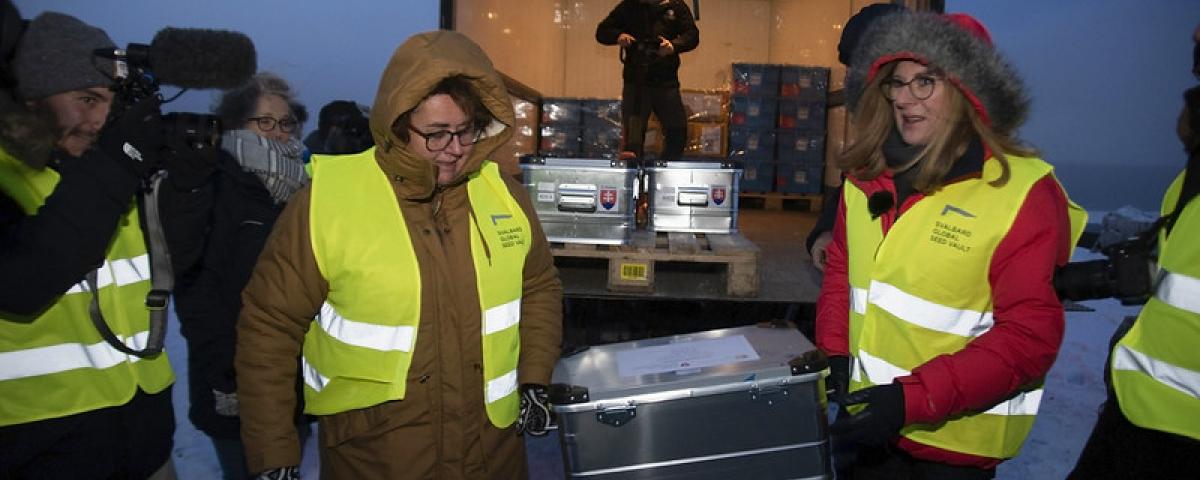

Hence a recent push to boost national gene banks, of which the Svalbard vault is a product. Their urge to make profits is not necessarily aligned with the wider cause of feeding mankind. Their gene banks are too small and too concentrated on a handful of commercial crops.

Yet biotech firms cannot be relied upon to look after crop biodiversity. It is trying to develop local varieties of maize (corn) and soyabean, which are not grown there commercially, but may be as the temperature climbs. It also has plans to cope with climate change, having recently opened a research outfit in chilly western Canada. He says the firm has drawn genetic material from its stock of wild American sunflower seeds three or four times in the past decade, in a bid to make its commercial varieties resistant to broomrape, a parasitic blight of southern Europe.

“If we ignore genetic diversity while we develop GMO products, we risk a disease or pest emerging that will wipe those types out,” says John Soper, head of crop genetics research at Pioneer Hi-Bred, the seed division of DuPont, a chemicals giant.
#DOOMSDAY VAULT ESSAY UPDATE#
That is why plant breeders, from poor smallholders to the world's biggest biotech firms, masters of the genetically modified organism (GMO), continuously update their genetic stock, often from obscure sources. Agricultural biodiversity is the best hedge against future blights, including pests, diseases and climate change. It is hard to quantify how much this matters but the long-term risks are potentially huge. Such measures probably underestimate the scale of the losses, because a single traditional seed variety often contains a lot of genetic diversity. America once had around 5,000 apple varieties, and now has a few hundred. India is reckoned to have had over 100,000 varieties of rice a century ago it now has only a few thousand. Yet, largely on the basis of named crop varieties that are no longer extant, the UN's Food and Agriculture Organisation estimates that 75% of crop biodiversity has been lost from the world's fields. The extinction of non-human species is generally better studied than the loss of the genetic material that sustains humanity. The extent of the loss, which continues today, is poorly documented. The idea was born of a realisation that a vast amount of agricultural biodiversity was being lost, as farmers abandoned old seeds, often locally developed over centuries, for the new hybrids. Most seed banks were created in the 1970s and 1980s, towards the end of a global surge in crop yields, wrought largely through the adoption of hybridised seed varieties, known as the Green Revolution. To augment this, he will also soon embark on a project, funded with $50m from Norway, to collect the seeds of many crops' wild ancestors. Mr Fowler, who manages it on behalf of Norway's government, an association of Nordic gene banks and an international body, the Global Crop Diversity Trust, reckons the vault contains samples of around two-thirds of the world's stored crop biodiversity. Such precautions have spawned the facility's nickname: the Doomsday Vault. He also enthusiastically points to its concave tunnel-head, designed to deflect the force of a missile strike. This is serious disaster preparedness: if its electricity were cut, Mr Fowler reckons the vault would take two centuries to warm to freezing point. It is maintained at a constant temperature of -18☌. The Svalbard vault is protected by two airlocks, at the end of a tunnel sunk 160 metres into the permafrost of Norway's Arctic archipelago, outside the village of Longyearbyen, one of the world's most northerly habitations. “When I see this,” says Mr Fowler, looking lovingly at his latest consignment, “I just think, ‘thank goodness, they're safe.'” Some 110,000 Syrian seed samples are now in the Svalbard vault, out of around 750,000 samples in all. Should the conflict in Syria reach that country's richest store, in Aleppo, the damage would now be less. Those of Afghanistan and Iraq were destroyed in recent wars. To illustrate the need for it, the Philippines' national seed bank was destroyed by fire in January, six years after it was damaged by flooding. Opened in 2008, the Svalbard vault is a backup for the world's 1,750 seed banks, storehouses of agricultural biodiversity.

For Cary Fowler, the vault's American architect, the Syrian chickpeas and fava beans were especially welcome. WITH a heavy clunk, the steel outer doors of the Svalbard Global Seed Vault closed on February 28th, shutting out a howling Arctic gale and entombing a tonne of new arrivals: 25,000 seed samples from America, Colombia, Costa Rica, Tajikistan, Armenia and Syria.


 0 kommentar(er)
0 kommentar(er)
